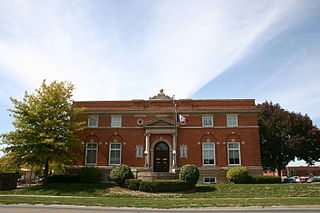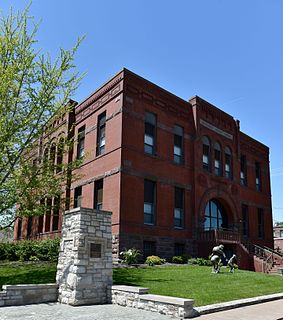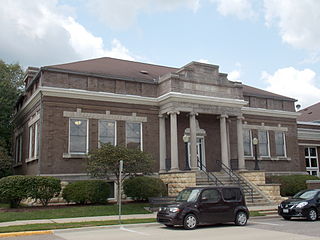
The Council Bluffs Public Library serves the residents of Council Bluffs, Iowa, United States along with unincorporated and rural areas of Pottawattamie County. Several cities also contract with the library to provide services. It dates back to 1866. The library is currently located on Willow Avenue. The previous library building on Pearl Street was listed on the National Register of Historic Places in 1999.

The Carnegie Free Library in Eureka, California was built in Classical Revival Style in 1902. It was listed on the National Register of Historic Places in 1986, and currently houses the Morris Graves Museum of Art.

The Eldon Public Library is a public library and historic building located in Eldon, Iowa, United States. Established in 1906, the present building, completed in 1913 with a donation from Andrew Carnegie, is listed on the National Register of Historic Places.

The Perry Carnegie Library Building, also known as the Carnegie Library Museum, is a historic structure located in Perry, Iowa, United States. The Perry Library Association was established in 1894, and William Tarr served as its first librarian. Andrew Carnegie accepted Perry's application for a grant for $10,600 on January 13, 1903. The Des Moines architectural firm of Liebbe, Nourse & Rasmussen designed the Neoclassical building that was built by local contractor Courtney and Bolt. It opened in September 1904 was dedicated on December 10.

Sigourney Public Library is located in Sigourney, Iowa, United States. After the Keokuk County Courthouse was completed in 1911 the local community formed a library committee to build a new public library. They purchased the property in 1912 and received $10,000 from the Carnegie Corporation of New York to fund the new building. The Chicago architectural firm of Patton, Holmes & Flynn designed the new library in a combination of the Bungalow and Colonial Revival styles. The single story brick structure is built on a raised foundation. It features an entrance that is slightly projected, a symmetrical facade, and it is capped with a hipped roof. It was dedicated in May 1914, and was one of 101 public libraries that were built in Iowa with assistance from the Carnegie Corporation. The building was listed on the National Register of Historic Places in 1983. The Sigourney Public Library moved to its present location in the renovated Blackie's Grocery Store building located on Iowa Highway 92 in 2005.

Laurens Carnegie Free Library is a historic building located in Laurens, Iowa, United States. It was designed by the Des Moines architectural firm of Wetherell and Gage and completed in 1910. The Carnegie Corporation of New York had accepted the application for a grant from Laurens' literary association for $3,800 on February 6, 1907. The Mission Revival structure measures 42 by 22.5 feet, and has a projecting pavilion for the main entrance. An addition was built onto the rear of the building in 1955. The building now houses the Pocahontas County Historical Museum. It was listed on the National Register of Historic Places in 1974.

The Clarinda Carnegie Library, now known as the Clarinda Carnegie Art Museum, is a historic building located in Clarinda, Iowa, United States. The Clarinda Public Library was organized in 1905. The library board applied for a grant from the Carnegie Corporation of New York for $15,000 on February 21, 1907. W.W. Welch was the architect of the Carnegie library building that was dedicated on April 15, 1909. In time the building became too small. The Lied Foundation of Las Vegas donated $1 million towards a new facility, and a special election held in October 2002 allowed the city to borrow the same amount for a new building. Groundbreaking for the new building took place on May 28, 2003, and the new Lied Public Library was opened on October 11, 2004. The old library building has been transformed into an art museum, and it was listed on the National Register of Historic Places in 2014.

The former Lake City Public Library is a historic structure located in Lake City, Iowa, United States. Efforts to establish a library began as early as 1889 when community socials were held to raise money for books. Women in the community, however, would not form a community library association until 1905. They sought donations of books and money from the community and were able to set up a subscription that year in the old primary building next to Central School. By 1908 there were 1,500 volumes in the library. The Association proposed to the city council in February of the same year that they turn their holdings over to the city for a free library. The council agreed to submit the proposal to the voters and the Association petitioned the Carnegie Corporation of New York for funds to build a new building. They accepted Lake City's application for a grant for $7,500 on May 8, 1908, and approved the library proposal in early June. S.T. and E.S. Hutchison donated the property. Denison, Iowa architect Edgar Lee Barber designed the Neoclassical building that was built by Nelson Construction Company. It opened in April 1910. There was no formal dedication. The building was listed on the National Register of Historic Places in 1990. The community has subsequently built a new library, and this building now houses a commercial business.

Oskaloosa Public Library is a facility located in Oskaloosa, Iowa, United States. Construction of the library was launched in 1902 with a grant from the Carnegie Corporation of New York. The building was added to the National Register of Historic Places in 1991.

Fairfield Public Library is located in Fairfield, Iowa, United States. A library association was founded by a group of local men in 1853, and funded by dues from its members. It was housed in several different buildings for the first 40 years. U.S. Senator James F. Wilson from Fairfield was instrumental in obtaining a grant from Andrew Carnegie for a building of its own. The grant for $40,000 was accepted on January 15, 1892. It was the first Carnegie Library outside of Western Pennsylvania and the first of 101 built in Iowa. It was also one the few libraries Carnegie funded without stipulations concerning its use, public support, or design. The building was designed in the Richardsonian Romanesque style by Kansas City architect C. Stafford. It was officially opened on Friday, September 29, 1893, and it was dedicated on November 28 of the same year. The association continued to run the library until 1899 when voters approved a referendum to support it with taxes. The building has been altered in the ensuing years, and it was listed on the National Register of Historic Places in 1983. The library moved to a new building in 1996, and the historic building is now home to the Jefferson County Service Center of Indian Hills Community College.

The Maquoketa Public Library is located in Maquoketa, Iowa, United States. The Maquoketa Literary Society was organized as early as 1851, and the Boardman Library Institute was founded in 1885. The community applied to the Carnegie Corporation of New York for a grant to build a free public library, and on March 14, 1902 they were awarded $12,500. The total cost of acquiring the property and constructing the building was $15,000, which they raised by public contributions and entertainments. Independence, Iowa architect Harry Netcott designed the Neoclassical building. It is a single-story brick structure that rests on a raised limestone basement. Bedford stone was used for the trim. It features a symmetrical facade, with columns in the Ionic order that frame the portico. The interior features a columned rotunda. It was dedicated on January 19, 1904. The Boardman Library Institute merged with the Free Public Library after the new building was completed. The roofline was altered slightly when a new roof was added around the middle of the 20th century.

The Vinton Public Library is located in Vinton, Iowa, United States. The community applied to the Carnegie Corporation of New York for a grant to build a public library, and on January 22, 1903 they were awarded $12,500. It was one of 22 public libraries in Iowa that were built with Carnegie grants that year, the most in the history of the program for both the state and the country. The Chicago architectural firm of Patton & Miller designed the Renaissance Revival building. It features a full parapet, hipped roof with a deck, and a Flemish gable. It was dedicated on August 25, 1904, and it has subsequently been expanded. The building was listed on the National Register of Historic Places in 1983.

Chariton Public Library is located in Chariton, Iowa, United States. The Library and Reading Room Association was formed in Chariton in 1879, but it was short-lived. The county superintendent of schools started a teachers' library in the courthouse sometime afterward. By this time the community had a library of 800 volumes. There was an effort by study clubs in town in 1898 to raise money and establish a free public library. The Chariton Federation of Women's Clubs took the lead and opened a library with the books from the courthouse in two rooms above Gibbons Drug Store on the town square. Citizens approved a local tax to support the library the following year.

Onawa Public Library is located in Onawa, Iowa, United States. The public library began in 1902 when Judge Addison Oliver offered to buy the former Congregational Church for a library building, and funds to buy books and fixtures. His offer was accepted by the community, which also promised to maintain the facility as a free library. The library soon outgrew the old church and in November 1906 the board of directors approached the Carnegie Corporation of New York for a grant to build a library building. A $10,000 grant was approved on December 13, 1907. Judge Oliver donated another $10,000 for the building, and an additional $10,000 for an endowment fund. The Chicago architectural firm of Patton & Miller designed the Prairie School building, which was dedicated on October 22, 1909. It was listed on the National Register of Historic Places in 1979.

Woodbine Public Library, also known as Carnegie Public Library, is located in Woodbine, Iowa, United States. The library was organized in 1907, and it was initially housed in the jail section of city hall. If there was inmate in the jail the public had no access to the library. The city council appointed a board of trustees in 1908 and they applied to the Andrew Carnegie for a grant to build a library building. They received a grant on April 28, 1909 for $7,500. Eisentraut and Company, a Sioux City architectural firm designed the Prairie School building. F.X. White of Eldora, Iowa was the contractor. The building was completed in February 1909, and it was dedicated on March 9 of the same year. This was the first library built in Harrison County.

The Carnegie-Ellsworth Public Library is a historic building located in Iowa Falls, Iowa, United States. Local businessman Eugene Ellsworth donated the property for the library in 1902. The following year the Carnegie Foundation agreed to grant the community $10,000 to build the building. It was dedicated on August 9, 1904. The single-story, brick structure is dominated by an elaborate entrance pavilion. It features a semi-circular window above the cornice, which is supported by two Ionic pillars in antis between rusticated corner piers. The hip roof is capped by a cupola. The building was listed on the National Register of Historic Places in 1983. The Robert W. Barlow Memorial Library, Iowa Falls' public library, is now housed in a modern building near the Iowa River.

The Former Eldora Public Library is a historic building located in Eldora, Iowa, United States. On December 30, 1901 the Carnegie Foundation agreed to grant the community $10,000 to build a new library building. The Chicago architectural firm of Patton & Miller designed it in the Renaissance Revival style, and it was dedicated on May 11, 1903. The single-story, brick structure is somewhat rare in that its plan is an asymmetrical massing of intersecting gables. The entrance pavilion is located at the intersection of the two masses. The building was listed on the National Register of Historic Places in 1983. In 2010 it was included as a contributing property in the Eldora Downtown Historic District in 2010. The library has subsequently moved to a new facility, and this building has been converted for commercial use.

The Mason City Public Library is located in Mason City, Iowa, United States. The building that was funded by Andrew Carnegie, and is now an office building, was listed on the National Register of Historic Places in 1989. It was included as a contributing property in the Mason City Downtown Historic District in 2005.

The Sioux City Free Public Library is a historic building located in Sioux City, Iowa, United States. The library was located in a section of the Municipal Building, no longer extant, between 1892 and 1913. It had outgrown the space when the Library Board contacted Andrew Carnegie in 1910 about providing the funding for a new library building. Their request was initially turned down. They chose to work with New York City architect Edward L. Tilton, an architect preferred by Carnegie, in place of local architect William L. Steele who was working with the board previously. Local resident George Murphy donated the property for the new building. Meanwhile, Tilton designed the two-story brick Renaissance Revival building. On April 8, 1911, Carnegie approved the project and donated $75,000 for the building's construction. The new building was dedicated on March 6, 1913, and it is considered "an excellent early twentieth century example of the architectural development of library planning and design." It was Tilton's only building in Iowa.

The Carnegie-Stout Public Library is located in Dubuque, Iowa, United States. The public library had its beginnings with the Young Men's Literary Association, established in 1859, and their book collection was the basis for the library's collection. The books were housed in a variety of buildings over the years. The community applied for a grant from Andrew Carnegie who on January 12, 1901 contributed $71,500 to build the library building. Local businessman Frank D. Stout donated the property, which was worth $20,000, in honor of his father Henry L. Stout. The two-story Bedford stone and brick building was designed by Chicago architects W. G. Williamson and John Spencer. It is considered one of the finest examples of the Classical tradition of Beaux-Arts architecture in Iowa. The main facade is dominated by a Roman Corinthian portico that was modeled after the Pantheon in Rome. Its fluted columns are matched with pilasters on the wall behind. The building was dedicated on October 17, 1902, and it opened three days later. It was individually listed on the National Register of Historic Places in 1975, and it was included as a contributing property in the Jackson Park Historic District in 1986. An addition was added to the east side of the building in 1981.























